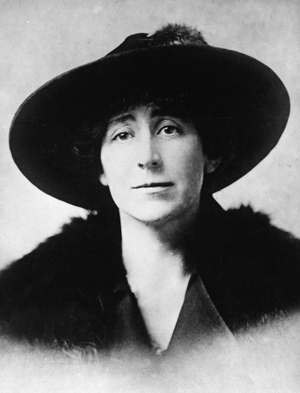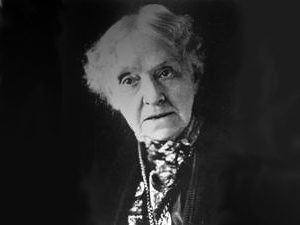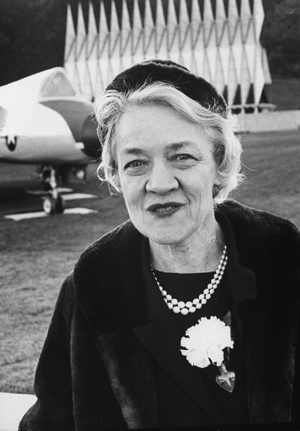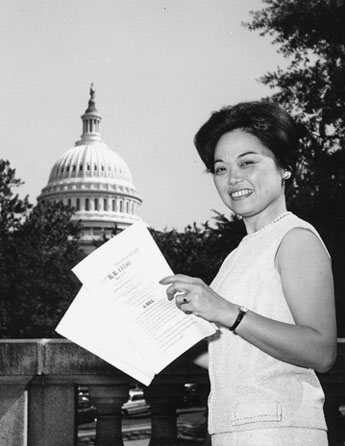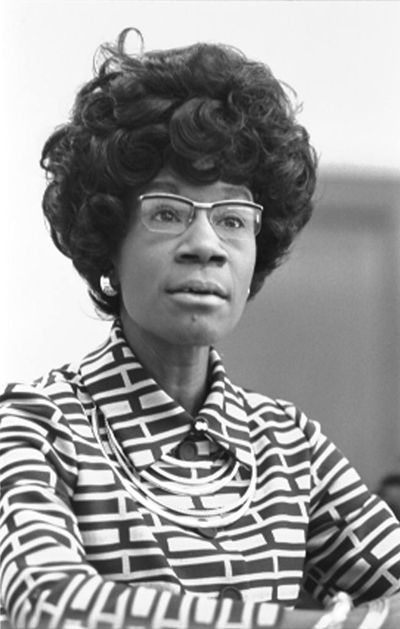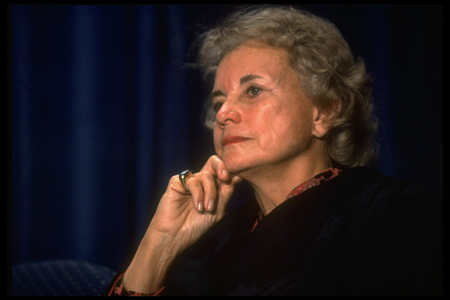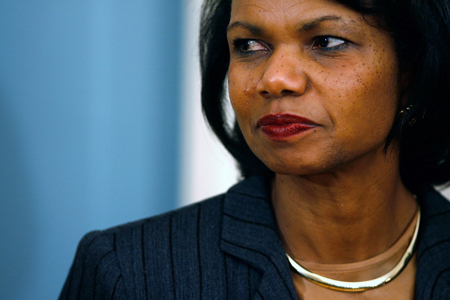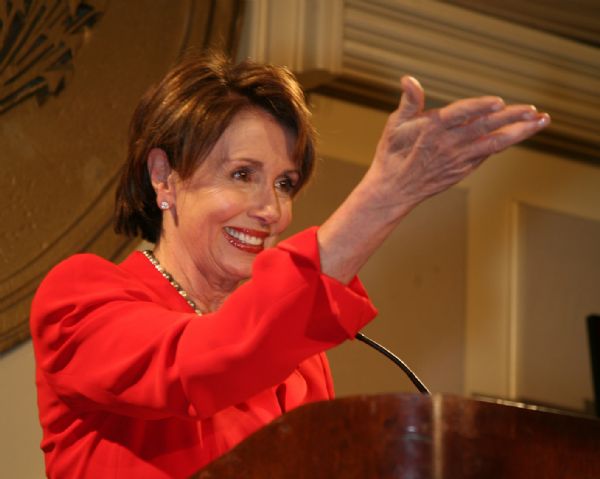Political Firsts
American Women, At a Glimpse
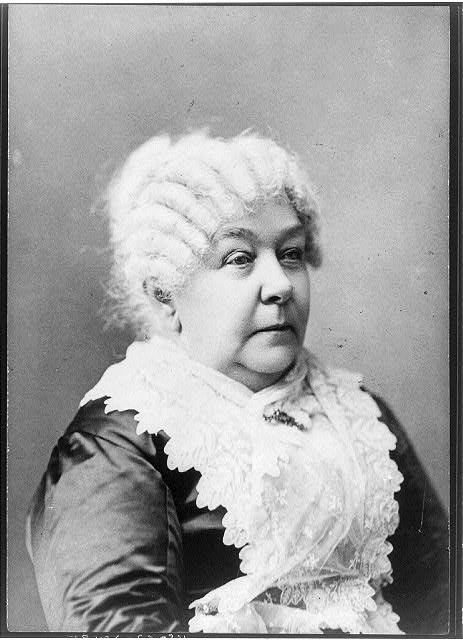
Elizabeth Cady Stanton was the first woman to run for the U.S. House of Representatives, even though she was not eligible to vote. She ran as an Independent from New York, receiving 24 of 12,000 votes cast.
1872
Victoria Woodhull, a stockbroker, publisher, and protégé of Cornelius Vanderbilt, ran for president of the United States on the Equal Rights Party ticket.
1884
Belva Lockwood, the first woman admitted to practice law before the U.S Supreme Court, ran for president on the Equal Rights Party Ticket; she did so again in 1888.
1887
Susanna Salter was elected mayor of Argonia, Kansas -- the first woman mayor in the country.
1900
Frances Warren of Wyoming became the first woman delegate to a Republican National Convention. In the same year, Elizabeth Cohen of Utah was chosen as an alternate to the Democratic National Convention. When another delegate became ill, Cohen became the first woman delegate to a Democratic National Convention.
1917
Jeannette Rankin, a Republican from Montana, entered the U.S. House of Representatives, the first woman ever elected to Congress. She served from 1917 to 1919 and again from 1941 to 1942; a pacifist, she was the only lawmaker to vote against U.S. entry into both world wars.
1920
After 72 years of struggle, the 19th Amendment to the Constitution was ratified, giving women the right to vote.
1920
The League of Women Voters was founded by members of the National American Woman Suffrage Association as a means of encouraging informed participation by the new female electorate.
1922
Rebecca Latimer Felton, a Georgia Democrat, became the first woman to serve in the U.S. Senate. She was appointed to fill a vacant seat temporarily; she served for only two days before giving up her seat to the man who had been elected to it.
1924
Bertha K. Landes, Republican city council president at the time, became acting mayor of Seattle, the first woman to lead a major American city. Two years later she was elected mayor in her own right in a campaign run by women. She lost in her bid for a second full term.
1925
Nellie Tayloe Ross, a Wyoming Democrat, became the nation's first woman governor, elected to replace her deceased husband.
1933
With her appointment by President Franklin D. Roosevelt as Secretary of Labor, Frances Perkins became the first woman ever to serve in a presidential cabinet. She served until 1945.
1933
Ruth Bryan Owen, a former congresswoman, became the first woman to hold a major diplomatic post when she was appointed by President Roosevelt as minister to Denmark. She held that post until 1936, when her marriage to a Dane and resulting dual citizenship made her ineligible to serve.
1964
Senator Margaret Chase Smith, a Maine Republican, was nominated for the presidency by Vermont Senator George Aiken at the Republican national convention. Elected to the House of Representatives in 1940 (to replace her dying husband) and the Senate in 1948, Smith had already made history by becoming the first woman to serve in both houses of Congress.
1965
Patsy Takemoto Mink, a Democrat from Hawaii, became the first woman of color and the first woman of Asian-Pacific Islander descent in the House of Representatives. She served until 1977 and was re-elected in 1990.
1966
The National Organization for Women was established to combat discrimination against women in every sphere. Its aim was to "bring women into full participation in the main-stream of American Society now."
1968
Shirley Chisholm, a New York Democrat, became the first Black woman to serve in Congress. She remained in the House of Representatives until 1982.
1971
The National Women's Political Caucus was formed. Its aims were to increase women's access to political power in the major parties and to encourage and support women committed to women's rights who seek elective and appointive office.
1972
Congresswoman Shirley Chisholm ran for president in the Democratic primaries. At the party's national convention, she garnered 151.25 delegate votes before Senator George McGovern clinched the nomination.
1974
The Women's Campaign Fund was formed for the purpose of "electing qualified progressive women of both parties to public office at every level." It was the first national political action committee with the specific goal of funding women's campaigns.
1977
Patricia Roberts Harris was appointed by President Jimmy Carter to serve as Secretary of Housing and Urban Development during 1977-1979. From 1979-1981, she served as Secretary of Health and Human Services. She was the first Black woman to serve in a presidential cabinet and the first woman to hold two different cabinet positions.
1978
Nancy Landon Kassebaum, a Kansas Republican, was elected to the United States Senate. Prior to her election, all of the women who served in the Senate had succeeded their husbands in Congress or had first been appointed to fill out unexpired terms.
1980
For the first time, a national party's nominating convention delegates included equal numbers of men and women. At its convention in New York, the Democratic Party also added to its charter a requirement that future conventions have equal numbers of female and male delegates.
1981
Sandra Day O'Connor, a former Republican state legislator from Arizona who had served on a state appeals court, was appointed by President Ronald Reagan as the first woman ever to sit on the U.S. Supreme Court.
1984
Third-term Congresswoman Geraldine A. Ferraro (D-NY), secretary of the House Democratic Caucus, became the first woman ever to run on a major party's national ticket when she was selected by Walter F. Mondale as his Vice Presidential running mate. The ticket was decisively defeated, capturing only 13 electoral votes, and few analysts felt that Ferraro's presence had a strong impact -- positive or negative -- on the outcome.
1986
Barbara Ann Mikulski, a Maryland Democrat, became the first Democratic woman elected to the Senate without previously filling an unexpired Congressional term. She was re-elected in 1992 and 1998.
1989
Ileana Ros-Lehtinen, a Florida Republican, became the first Hispanic woman and first Cuban American to be elected to Congress. She was elected in August 1989 in a special election and continues to serve.
1992
Nydia Velasquez, a New York Democrat, was elected in 1992, becoming the first Puerto Rican woman to serve in Congress. She continues to serve.
1992
Carol Moseley Braun, an Illinois Democrat, became the first African- American woman and the first women of color to be elected to the U.S. Senate. Her term ended in 1999 when she lost her re-election bid.
1993
Janet Reno became the first woman to serve as U.S. Attorney General. She served in President Bill Clinton's cabinet from 1993-2001.
1997
Madeleine K. Albright, became the first woman to serve as U.S. Secretary of State, serving from 1997-2001. She became the highest-ranking woman in the U.S. government but, as a naturalized citizen, she would not have been eligible to become President.
1998
Tammy Baldwin, a Democrat from Wisconsin, became the first openly gay or lesbian person elected to Congress as a non-incumbent. She was also Wisconsin's first woman in Congress.
2001
Hillary Rodham Clinton became the first woman elected to the U.S. Senate from New York, the only First Lady ever elected to public office. She won an open seat in a general election.
2001
Condoleezza Rice became the first woman to hold the post of National Security Advisor when she was appointed by President George W. Bush.
2001
Elaine Chao became the first Asian-American woman to serve in a presidential cabinet when she was appointed Secretary of Labor by President George W.Bush.
2001
Ann Veneman was appointed by President George W. Bush to be the first female Secretary of Agriculture. She had previously been the first woman to serve as Secretary of the California Department of Food and Agriculture.
2001
Senator Kay Bailey Hutchison (R-TX) became the first woman to hold the position of vice-chair of the Senate Republican Conference during the 107th Congress (2001-2003).
2001
Senator Patty Murray (D-WA) became the first woman to serve as chair of the Democratic Senatorial Campaign Committee.
2001
Sila Calderon (Popular Democratic Party), former mayor of San Juan, became the first woman governor of Puerto Rico.
2002
Representative Nancy Pelosi (D-CA) became the first woman to head her party in Congress when she was elected by her colleagues as House Democratic Leader.
2002
The election to Congress of Linda Sanchez (D-CA) meant that for the first time, two sisters served together in the House. Representative Loretta Sanchez (D-CA) was first elected to the House in 1996.
2005
Dr. Condoleezza Rice became the first Republican woman and the first African-American woman to serve as U.S. Secretary of State.
2005
Washington state became the first state to have both a woman governor (Christine Gregoire, D) and two women serving in the U.S. Senate (Patty Murray, D and Maria Cantwell, D).
2007
Representative Nancy Pelosi (D-CA) became the first woman Speaker of the U.S. House.
2008
Senator Hillary Rodham Clinton became the first woman to win a major party's presidential primary for the purposes of delegate selection when she won the primary in New Hampshire on January 8.
Facts and Findings courtesy of the Center for American Women and Politics, Eagleton Institute of Politics, Rutgers University.


